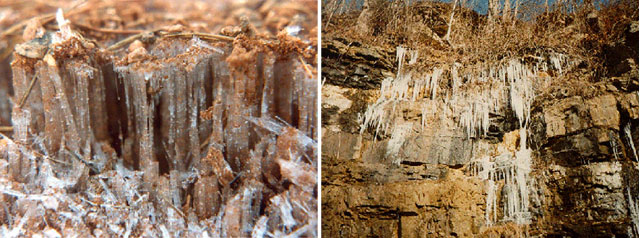
Weathering (Part 1)
Weathering refers to the changes in rocks at or near earth’s surface as they are exposed to the atmosphere, water, or organisms. Weathering can occur by physical or chemical processes and depends on the climate and other factors. Soil is formed by weathering processes.
Physical Weathering
Physical weathering occurs when rocks are broken into smaller pieces with no chemical changes. Physical weathering is also called mechanical weathering or disintegration. Several processes cause physical weathering including: frost action, exfoliation, and organic activity.
Frost Action and Temperature Changes
• Frost action occurs when water freezes and expands in open spaces in rocks, pushing fragments apart.
• Daily or seasonal heating and cooling causes rocks to expand and contract, breaking them along grain boundaries.

In the left photograph, frost has lifted soil grains and sticks off the ground. In the right photograph, ice has formed along the bedding planes at a cliff in Radford. Expansion of water as it freezes helps to break rocks apart. (Left photograph by Stan Johnson, right photograph by Robert Whisonant)